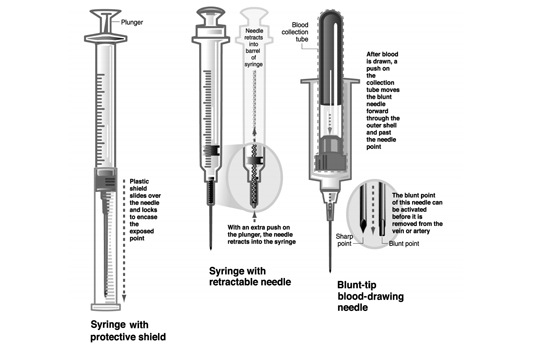
Prevention and Management of Needlestick Injuries in Health Care Settings
The National Institute for Occupational Safety and Health (NIOSH) requests assistance in preventing needlestick injuries among health care workers.
These injuries are caused by needles such as hypodermic needles, blood collection needles, intravenous (IV) stylets, and needles used to connect parts of IV delivery systems. These injuries may cause a number of serious and potentially fatal infections with bloodborne pathogens such as hepatitis B virus (HBV), hepatitis C virus (HCV), or human immunodeficiency virus (HIV)—the virus that causes acquired immunodeficiency syndrome (AIDS). These injuries can be avoided by eliminating the unnecessary use of needles, using devices with safety features, and promoting education and safe work practices for handling needles and related systems. These measures should be part of a comprehensive program to prevent the transmission of bloodborne pathogens. This Alert provides current scientific information about the risk of needlestick injury and the transmission of bloodborne pathogens to health care workers. The document focuses on needlestick injuries as a key element in a broader effort to prevent all sharpsrelated injuries and associated bloodborne infections.
The document describes five cases of health care workers with needlestick-related infections and presents intervention strategies for reducing these risks. Because many needleless devices and safer needle devices have been recently introduced and the field is rapidly evolving, the Alert briefly describes an approach for evaluating these devices. NIOSH requests that workers, employers, manufacturers, editors of professional journals, safety and health officials, and labor unions implement the recommendations in this Alert and bring them to the attention of all health care workers who use or may be exposed to needles in the workplace.
[document url=”http://www.cdc.gov/niosh/docs/2000-108/pdfs/2000-108.pdf” width=”600″ height=”700″]


